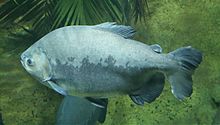Tambaqui
| Tambaqui Temporal range: Miocene - recent |
|
|---|---|
 |
|
|
Not evaluated (IUCN 3.1)
|
|
| Scientific classification | |
| Kingdom: | Animalia |
| Phylum: | Chordata |
| Class: | Actinopterygii |
| Order: | Characiformes |
| Family: | Serrasalmidae |
| Genus: |
Colossoma C. H. Eigenmann & C. H. Kennedy, 1903 |
| Species: | C. macropomum |
| Binomial name | |
|
Colossoma macropomum (G. Cuvier, 1818) |
|
| Synonyms | |
|
|
The tambaqui (Colossoma macropomum) is a freshwater species of serrasalmid. It is also known by the names black pacu, black-finned pacu, giant pacu, cachama, gamitana, and sometimes as pacu (a name used for several other related species).
The tambaqui is the largest characin of South America, found in the Amazon and Orinoco basins in its wild form. However, its pisciculture form is widely distributed in South America.
The tambaqui is located all throughout Brazil and even though they can be found in different locations in Brazil, all of the tambaqui do not have a genetic diversity.
It may reach more than 1 m (3 ft 3 in) in total length and 40 kg (88 lb) in total weight.
It is similar in shape to the piranha and is sometimes confused with the carnivorous fish; the tambaqui is tall and laterally compressed with large eyes and a slightly arched back. Body color is basic black to gray with spots and blemishes in its midbody. All the fins are black and the pectoral fins are small. Around 10% of a tambaqui's weight is fat. The world record recognized by IGFA belongs to the Brazilian Jorge Masullo de Aguiar with 32.4 kg (71 lb).
This species is usually solitary. Adults stay in flooded forests during the first five months of flooding, and consume fruits and grains. Young and juveniles live in black waters of flood plains until sexual maturity. The tambaqui feeds on zooplankton, insects, snails, and decaying plants. The species plays an important role in dispersing seeds from fruits.
Tambaqui is a fish that lives in freshwater. Salinity up to 10gL causes an effect in their hematological parameters. Their freshwater cannot have more than 15gL of salinity before tambaqui start to die. Salinity above 15gL causes there to be a change in weight, consumption, and growth rates.
When there is not enough oxygen in the river or lake, tambaqui obtain oxygen from the air. They are able to do this by their physical and inner body parts, such as their gills and swimbladder vascularization.
...
Wikipedia
